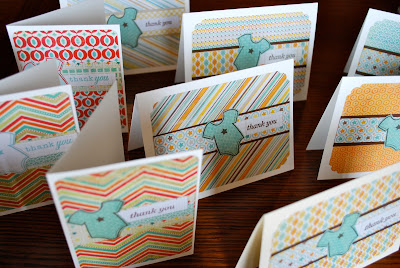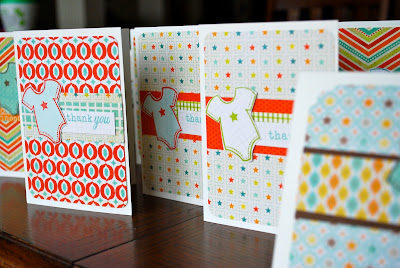It's springtime - in our house, this usually means I get the itch to decorate, organize and switch things up. We've been in our current house 6 years, and it was about time to add a little pizazz to our master bath.
Previously, it was painted with a builder grade contractor paint - blah and boring. I decided that I wanted to do a Harlequin faux finish. In a past life of mine (i.e. before the twins), I painted for a living. And, when I was doing painting, this finish was kind of a trade secret - at least the "how-to" was. So, I pretty sure I'm giving up the secret. If I was a magician, they'd probably throw me out of the club, or revoke my rabbit and hat. Something like that anyway.
Here goes - Interested in doing a wall finish like this?
Ok - here is the step-by-step. It is very detailed, but much easier than it sounds. If you have any questions, please let me know. I'd be happy to answer them:
MATERIALS:
- Eggshell or Satin basecoat (and all the materials to paint the room.)
- Painters tape
- Glaze of choice - I used a light brown.
- Tool for applying glaze
- Small paint brush for applying finish around trim and doors
- 2 rolls of clear contact paper
- Ruler
- Scissors
- Level
-Patience (Just kidding! This is pretty easy!)
#1 - BASECOAT I applied the basecoat to my walls. The paint finish should be either satin or eggshell. This is so when I applied my glaze, it will slide across the surface and not stick where I put it (making it look "splotchy" - 1990's spongeing, anyone?) I used a Benjamin Moore neutral.
#2 - 1ST COAT OF GLAZE After my basecoat dried, I mixed a glaze and applied it to the wall. You can make a glaze using a number of products. I prefer either Aqua Cream or Aqua Glaze and colorant, but you can also use a paint and a product called Floetrol. It basically will create a glaze from any color paint, but use the paint SPARINGLY...you are trying to create a "see-through" layer, not an opaque layer. I think the ratio of paint to Floetrol is on the bottle.
You need to make enough glaze to cover the area you are working on TWICE. If you don't make enough glaze the first time, you will be forced to try and match the first glaze you made. I make more than enough and if I have extra, it's always better than trying to match. Plus, if you ever need to fix a wall, then you have the product that you need. I store the extra in a airtight container.
Apply the glaze to the tool of choice. I like the Woolie. You can also use a rag. I've found the Woolie is the fastest way to get your glaze spread around.
Using a small brush, I spread the glaze on the surface of the woolie so that it is covered.
Then, I applied the glaze to the wall.
I used the small brush to get close to the trim. I applied the glaze to the entire wall and let dry for at least 24 hours. This is important because if you try the next step too soon, you will wreck what you've already done.
#3 - MAKING DIAMONDS While the glaze is drying, I moved onto the next step - creating diamonds! Here's where the trade secret comes into play. There is no taping involved. I know, hard to believe. But, I speak the truth! I use clear contact paper. It's great because it's sticky on the back so that you can easily reposition it without a ton of hassle.
Why am I using contact paper? When you apply the contact paper diamond to your wall that has already been glazed, it creates a barrier. When you apply the second coat of glaze over the wall, the contact paper is "protecting" the wall just in that spot from getting the second coat of glaze. So, when you remove the contact paper, the portion of the wall that was protected appears lighter than the part of the wall that got two coats of glaze applied to it. Does that make sense?
Deciding your diamond size:
CAUTION - this step requires measuring and math - I'm horrible at both these things. So, if I can do it, so can you!
In order to determine what size I wanted my diamonds, I measured the height of the wall I was going to apply the finish to - This is important because if you're diamonds are too small, your wall will look super busy and if they are too large, you won't be able to see the effect of the pattern. Make sense? Ok.
My ceilings are 12 feet high in the tallest point that I would be working. I decided my diamonds would be 21 inches long and 12 inches wide (about 3/4 of the height). If you are intimidated by this measuring and figuring, you can also create this pattern using squares that are turned tip to tip in the pattern. But, I like the diamonds better.
The other great thing about the contact paper is that there are measurements on it. See?
Every dot is 1/2 inch. And there are also 1 inch measurements down the side.
This is what you want to end up with.
So I measured every 21 inches vertically (because that is the HEIGHT of my diamond) and drew a horizontal line. You can see this line in the picture above. And you can faintly see this same horizontal line at the bottom of the diamond.
Then using my ruler, I measured 11 inches from the top line - which is the halfway point. This is the dot that I circled in middle. I had 10 inches above and 10 inches below that spot.
Once I determined my mid-point (where the diamond would be the widest, or where the points would be) I measured 6 inches out from the left and from the right of that middle dot for a total width of 12 inches.
Then, I connected the dots by drawing the diagonal lines.
Then, I cut out the diamonds.
Here's the pattern I created on the wall. It's a little easier to see when the backing paper is still on. For the size diamond I made, I got about 8 per roll of contact paper. The more diamonds you make, the easier it is to do the finish.
#4 - APPLICATION - The fun finally begins!
I peeled the contact paper away from the backing paper.
Then, I stuck it on the wall. You can eyeball this pretty well using the points of the diamond to make sure it's level, but for the first few, I like to use a level just to get the pattern started. Believe me, after all the steps you've taken, you don't want to get a pattern going all cattywampus. A complete do-over would be super frustrating, so it's easier to take the extra time now and make sure everything is level to begin.
Here you can see about 4 diamonds laid out.
And here are all 8 diamonds making my pattern on the wall.
As the light hits them from a different angle, they are a little easier to see. You might also notice that they are not completely perfect laying flat against the wall. There are a few wrinkles here and there. To me, this is the beauty of a faux finish. It is hand-applied. It is not wallpaper.
And, there are parts where my diamond points don't line up exactly like they should. I attribute this to cutting out the diamonds by hand. Again, not a mass-produced wallcovering, but something you CREATED!
I've done this step before - I applied the glaze to my tool of choice.
I spread it around for good coverage.
I applied it to the wall, making sure the diamonds were covered. This is important because it order to see the pattern, you need to hit all the edges.
I made sure to get the nooks and crannies!
And, VOIL-A! When you peel back your contact paper, you will have a portion of the wall that appears lighter in color than where you just applied the 2nd coat of glaze.
Remember the part about the contact paper being sticky and how great that is? Here's an example. It makes it super easy to work around doorways and get your pattern up close to the trim.
And, it also makes it easy to wrap the pattern around corners, if you need to.
But, since I only had 8 diamonds, I had to work in sections. Once I would get my glaze applied to an area, then I would peel the diamond off the wall in that spot and move it to the next part that needed to be done. I continued in this fashion - glazing, moving, glazing, moving across the wall until my wall was completed.
Ta-Da!

























































